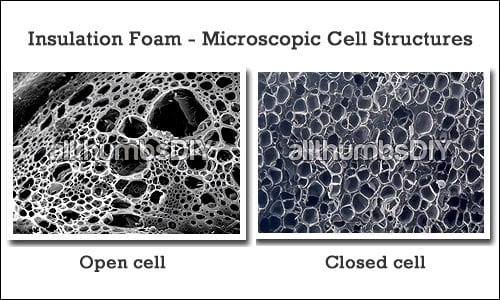There are two main types of polyurethane spray foam insulation: open vs closed cell foam insulation. Both open cell and closed cell foam insulation are used to stop the air flow and provide resistance to heat flow but there are few major differences between the two types, leading to advantages and disadvantages over the other.
Open Cell Foam Insulation
Open cell foam insulation is usually found in application densities ranging from 0.5 to 1.5 lbs per cubic feet, thus it is also referred to as half pound or low density foam. It cures into a softly textured (“spongy”) foam with irregular and broken bubbles containing air, similar to a cushion or foam packaging material molded inside a plastic bag to custom fit a particular item being shipped (i.e. expensive digital SLR camera).
Because pockets fill with air, the R-value of open cell foam insulation is close to that of conventional fiberglass insulation. And like the conventional fiberglass insulation, open cell foam insulation can absorb moisture so it should not be used in exterior environment where it can be in direct contact with water.
When getting a SPF (Spray Polyurethane Foam) quote using open cell foam insulation, it is critical that the thickness of the sprayed foam is clearly mentioned in the proposal.
Icynene (now Huntsman) Company is one of many open cell foam manufacturers.
Closed Cell Foam Insulation
Closed cell foam insulation is known as 2 pound or high density foam. It cures to a fully bonded, monolithic rigid form, providing increased shear and racking strength. It contains millions of microscopic intact bubbles containing the reaction gas, providing higher R-value than open cell foam. Approximately three inches of closed cell foam will provide R-21 for exterior walls. To accomplish the same R-value rating, open cell foam must be laid down at 7 inches with moisture permeation and inferior air penetration deflection.
Closed cell foam is naturally low in vapor permanence due to their cell structure. Depending on the thickness, Closed cell foam insulation can be used as a vapor barrier. Foam Lok and InsulStar are both examples of closed cell foam (again, sold in bulk as spray foam, not in cans).
Although open and closed cell form insulation are commonly used in commercial and residential settings, some are inappropriate in specific applications. For example, you typically would not use open-cell foam below grade where it could absorb water; this would negate its thermal performance because water is a poor insulator compared to air and moisture may promote mold and/or bacteria growth. Closed-cell foam would be a good choice where small framing sizes need the greatest R-value per inch possible. Basically, the choice depends on the conditions of each installation.
Side-by-Side Comparisons
| Parameter | Open Cell | Closed Cell |
|---|---|---|
| R-Value | Good (R=3.5) | Great (R=6+) |
| Density | Low, 1/2 lbs cu/ft | Medium, 2 lbs cu/ft+ |
| PERM rating | High (bad) | Low (good) |
| Air Barrier | Yes-at full wall thickness | Yes |
| Absorbes Water | Yes | No |
| Misc | Good sound barrier | Great racking/shear strength |
If you have smaller projects, like sealing up a door or window, a small dispensing can is the right way to go. Click here for the product review.
Suggestions
- Moisture moves due to differential pressures between the inside and outside of the structure. Sealing up a structure may cause imbalance causing problems to building as well as to your health. You may want to hire a professional engineer (not an architect or HVAC “guy”) to review your HVAC system. S/he should give you a recommendation to take the appropriate action (to either increase or decrease the size of your HVAC system).
- If you are spraying in a new construction home (pre-drywall), you may need to let the foam fully cured (no more expansion) before installing drywall to reduce any chances of the walls buckling or moving during season changes.
- If you have a small job, like sealing up a window, click here for product reviews.


Kamelot
Wednesday 1st of February 2017
Not sure how old this artcile is, but anyway, regarding the open cell vs closed cell, what about this? Forget about HVAC for a moment. I am not sure how permeable/breathable wood is but if you insulate your house with closed cell foam how are you going to get rid of the moisture (indoor humidity) from breathing, cooking, washing and drying? Because you practically live in a plastic bag... Solution like running a dehumidifier or leaving the windows open sucks, to be honest... Air vents in bathroom and wash room are acceptable.
Reviews – GreatStuff vs DAPtex vs Touch-n-Foam
Saturday 25th of February 2012
[...] Small foam cans come in two basic varieties. Latex (open cell) or Polyurethane (closed cell) foams. If you would like to read more in detail about functional differences, go here. [...]